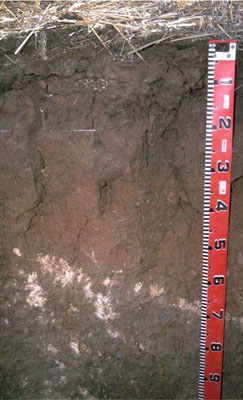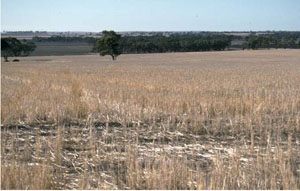LS1
|
| LS1 |  Calcic, Mottled-Subnatric, Red Sodosol | |
|
Location | Kinimakatka, western Victoria | |||
|
Landform | Gently undulating rises | |||
|
Geology | Quaternary Woorinen Formation: aeolian dune sand, calcareous clay | |||
|
Element | Hillslope (upper) | |||
Horizon | Depth (cm) | Description | ||
A1 | 0–10 | Dark brown (7.5YR3/4); sandy clay loam; weakly structured; weak consistence (dry); pH 6.0. | ||
A2 | 10–15 | Brown (7.5YR4/4); sandy clay loam; weakly structured but tends to fracture into platy like fragments; very strong consistence (dry), possible cultivation pan; pH 6.5; sharp boundary to: | ||
B21 | 15–25 | Reddish brown (5YR4/4) and dark reddish grey (5YR4/2) heavy clay; strong very coarse prismatic structure; very strong consistence (dry); pH 7.3. | ||
B22 | 25–60 | Yellowish red (5YR5/8) with dark reddish grey (5YR4/2) mottles; heavy clay; strong very coarse prismatic, parting to moderate blocky structure; pH 9.2. | ||
B23 | 60–100 | Yellowish brown (10YR5/4) with slight red mottles; medium heavy clay; moderate medium prismatic (finer than above), parting to moderate medium blocky structure; contains a common (1020%) amount of soft and nodular carbonate in pockets and very few (2%) ferruginous nodules; pH 9.4. | ||
| Management considerations | ||||
| ||||
Site LS1 | Sample depth cm | pH | EC dS/m | NaCl % | Ex Ca cmol-/kg | Ex Mg cmol-/kg | Ex K cmol-/kg | Ex Na cmol-/kg | Ex Al mg/kg | Ex acidity cmol-/kg | FC -30okPa | PWP -1500okPa | KS % | FS % | Z % | C % | |
Horizon | H2O | CaCl2 | |||||||||||||||
A11 | 0–10 | 6 | 5.5 | 0.29 | <0.05 | 7.5 | 1.5 | 0.6 | 0.1 | NA | NA | 17.8 | 6.7 | NA | NA | NA | NA |
A12 | 10–15 | 6.5 | 5.7 | 0.12 | NA | 8.5 | 3.9 | 0.6 | 0.3 | NA | NA | 17.5 | 8.1 | 33 | 36 | 6 | 20 |
B21 | 15–25 | 7.3 | 6.5 | 0.27 | <0.05 | 10.2 | 7.3 | 0.9 | 2.3 | NA | NA | 28.6 | 13.2 | NA | NA | NA | NA |
B22 | 25–60 | 9.2 | 8.5 | 0.58 | <0.05 | 7.3 | 10.7 | 1.1 | 7.6 | NA | NA | NA | NA | NA | NA | NA | NA |
B23 | 60–120 | 9.4 | 8.8 | 0.99 | 0.13 | 7.0 | 10.5 | 0.7 | 9.4 | NA | NA | NA | NA | NA | NA | NA | NA |
B24 | 120+ | 8.4 | 7.8 | 0.42 | NA | 4.6 | 11 | 0.9 | 10.2 | NA | NA | NA | NA | NA | NA | NA | NA |



